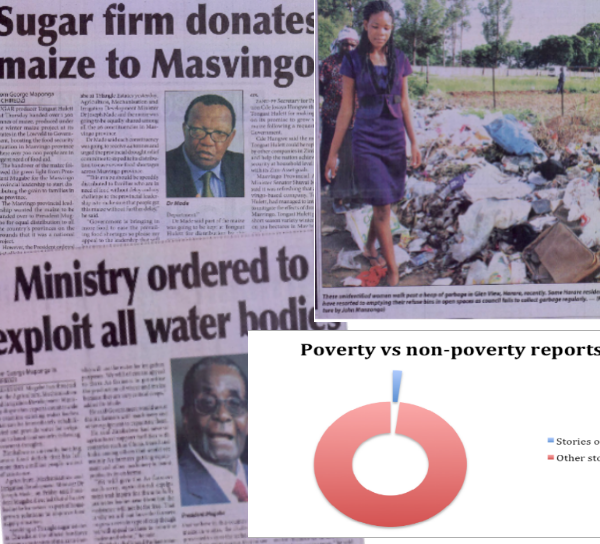03 May Reporting poverty in Zimbabwe

A media monitoring report
Media Monitors, Zimbabwe*
Media Monitors and the Zimbabwe Union of Journalists monitored 19 local media outlets for 30 consecutive days in April 2016 to understand the quality and nature of news reporting on poverty.
Applying a methodology adapted from the Global Media Monitoring Project, the research uncovered the following:
- Less than two percent (1.98%) of the stories focused on poverty, which is ironic given that almost 70 percent of the population lives in poverty.
- Privately owned publications contained more stories on poverty than the public newspapers. Private media carried 59.7 percent of all the stories on poverty as compared to the public media’s 40.3 percent. The most reported issue was hunger and the lack of food with 23 percent of stories on poverty focusing on this issue.
- Men’s voices far overshadowed those of women in the newspapers monitored. 75.2 percent of the quoted sources were men, as compared to the 18.7 percent of female sources. It is ironic that although there are more women affected by poverty, there are fewer women who actually speak on the issue. While on average, newspapers featured low numbers of women, the Manica Post, which publishes in the Eastern part of Zimbabwe, had no women at all quoted in the news reports published during the monitoring period, while the Zimbabwe Independent had the highest percentage voices of women at 30 percent.
- Of the 426 sources quoted on radio, women were quoted 23.5 percent of the time, while men’s voices made up 70.2 percent of quoted sources. Radio Zimbabwe had the highest percentage female sources with 40 percent speaking on the station, as compared to 45 percent men. Channel Zim had the lowest percentage of women’s voices with only 15 percent.
- While men are represented as solution holders to poverty alleviation, women are depicted mostly as victims of poverty. The caption from the … newspaper below shows a picture of “unidentified women” walking past a heap of rubbish. Not only are the women unidentified and nameless, but they are also the picture of the “residents” who are affected by poor service delivery.
- “Sex work”, poverty and children: A dimension widely explored by the media was on the abuse of young girls who had been forced into “sex work” by poverty. There were continued references to “child commercial sex workers”. Star FM reported that, “Child commercial sex workers lament abuse from clients”. The use of the term child commercial sex workers itself is not challenged. There is an assumption that girls firstly can actually make decisions to go into sex work. The abusive men in the article are actually referred to as “clients” and the story fails to analyse the criminal nature of sex work involving children. This kind of language sanitizes the recruitment of young girls into sex work. Poverty was also cited as one of the drivers forcing young girls into sex work since they have “limited options for survival”.
The report points out that “the media can contribute to adding to or dispelling any stereotypes that prejudice people living in conditions of poverty. Ideally they, in the public interest, should challenge the portrayal of women as victims of poverty, the view that people living in poverty are dependent, desperate and gullible or that they lack innovation to overturn their fortunes”.
Access the full report here.
*Media Monitors is a Zimbabwean NGO that conducts media monitoring and analyses trends in the Zimbabwean media. Media Monitors vision is of a quality media that works in the public interest; supporting an informed and engaged citizen. http://www.mediamonitors.org.zw/

No Comments